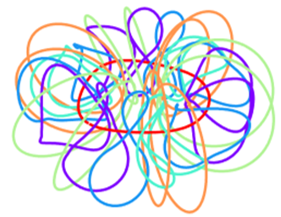Physics majors present their research
Ben Krewson: Defect Dynamics and Selection for Quenched Striped Patterns
We study transverse modulational dynamics of striped pattern formation in the wake of a directional quenching mechanism. Such mechanisms have been proposed to control pattern-forming systems and suppress defect formation in many different physical settings, such as light-sensing reaction-diffusion equations, solidification of alloys, and eutectic lamellar crystal growth. Furthermore, they are a simple model of a growth process in a patterned biological system. In the context of the complex Ginzburg-Landau and Swift-Hohenberg equations, two prototypical models of pattern formation, we show that long-wavelength and slowly varying modulations of striped patterns are governed by a one-dimensional viscous Burgers equation, with viscous and nonlinear coefficients determined by the quenched stripe selection mechanism. This reduced model allows for accurate description of defect dynamics as shock/rarefaction dynamics.
Troy Schneider: Structured Glass-Ceramic Scintillators
We studied compounds with a desirable x-ray mass attenuation coefficient, such as Terbium Oxide and Gadolinium Fluoride, which are very good at absorbing x-rays and turning them into visible light. This makes them quite useful in medical imaging devices such as x-rays. We varied the amount of these chemicals and observed the changes in the glass-ceramic. We also looked into alternative chemicals with better mass attenuation coefficients. We found that the Terbium Oxide and the Gadolinium Fluoride were very useful in attenuating x-rays, and that altering the percentages of a few other materials in the glass, such as Calcium Fluoride, produced a more stable glass at high energies.
Lauryn Williams: Identifying Dynamical Masses of Long Period Companions using Orbit Fitting Code with HGCA Astrometry
Sweeping advances in space telescopes paired with the innovative methods of computational astronomy give us a unique opportunity to detect and measure the dynamical masses of substellar companions orbiting stars outside our solar system. ESA’s space based HIPPARCOS and Gaia observatories have yielded precise astrometric measurements that -- when combined-- open a window on the detailed astrometric behavior of stars. Brandt et al. 2021 recently created the cross-calibration Hipparcos-Gaia Catalog of Accelerations (HGCA). In this work, we concentrate on 46 accelerating stars within 20pc of our sun focusing on those objects with long-term precise radial velocity curves from Keck’s HIgh Resolution Echelle Spectrometer (HIRES). Combining the acceleration information with the radial velocity curve, we use the complex orbit-fitting code called ORVARA (Orbits from Radial Velocity, Absolute, and/or Relative Astrometry), to obtain explicit constraints on the dynamical masses of the companions. Preliminary results have yielded the dynamical masses for companions around two well studied stars: 14 Her and 15 Sge. There remain 44 sources within 20pc that can be further analyzed. Studies of these accelerating stars are a pathway to understanding the hidden multiplicity fraction of our solar neighborhood. This research was possible through the RGGS-AMNH REU Program, funded by the National Science Foundation.
Brandon Lee: Stellarator Coil Optimization Supporting Multiple Magnetic Configurations
Effective and efficient stellarator optimization is of great interest to the nuclear fusion community. Our goal in this work is to develop techniques that can be used to design devices capable of supporting multiple magnetic configurations. Such devices would presumably be much more economical than those optimized for a single magnetic configuration. We utilize PyPlasmaOpt, a Python package that couples coil and vacuum field optimization, as our base software. Our primary methods for adding flexibility to the coil design are adjusting the currents in the modular coils and adding control coils to the device. We find that changing the currents in the modular coils without the addition of control coils leads to flexible stellarators with very irregular coil shapes and minute plasma volumes. By adding control coils, we introduce enough degrees of freedom to achieve multiple magnetic configurations with one coil configuration while maintaining reasonable coil shapes and low quasisymmetry error and creating larger plasma volumes. We add quadratic flux minimizing surfaces to the optimizations to increase the plasma volumes further. Overall, we achieve greater flexibility by accounting for multiple magnetic configurations during the coil design stage.
Join Zoom Meeting
https://umsystem.zoom.us/j/91469853371?pwd=b3p0disxMlhGTm9wcW1zSms3ZjZDdz09
Meeting ID: 914 6985 3371
Passcode: 505674
